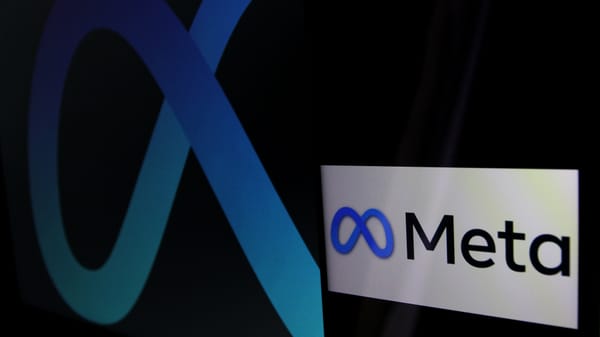The dream of the Fediverse is alive on Threads
Decentralized media is off to an agonizingly slow start — but there are glimmers of progress

A couple of weeks from now, it will have been two years since Meta introduced Threads. From the start, everything about the app seemed unlikely, starting with the fact that Meta was introducing a bare-bones Twitter clone in the year 2023.
But nothing about the app was more unusual than the fact that Meta said it would make Threads part of the Fediverse: that collection of social products connected with open protocols. After decades of building extremely lucrative walled gardens like Facebook and Instagram, Meta said it would make Threads interoperable with other products built on the ActivityPub protocol.
To the surprise of some, the company actually followed through. It built features to let Threads users share their posts to the Fediverse, meaning that someone who preferred Mastodon could follow a user on Threads and see that user's posts in their Mastodon feed. They also enabled Fediverse replies to Threads posts for those who opt in, and let Threads users follow Fediverse accounts.
Despite Threads' efforts, the Fediverse remains far from a mainstream phenomenon. Threads, which has 350 million monthly users, is the largest app in the network by far. Mastodon, which created the underlying protocol and was previously the biggest app in the network, has fewer than 800,000 monthly users. The rest of the Fediverse, which includes YouTube clone PeerTube and photo-sharing service Pixelfed, adds only around 300,000 total unique users.
Meanwhile Bluesky, a decentralized app built on the rival AT Protocol, registered an impressive 36 million users — but fewer than 4 million of those were active in the past week. Slate's Luke Winkie wrote last week that the app has been in a "frustrating downward spiral" owing to its monolithic leftist politics and culture of aggressive scolding in the replies.
Meanwhile, X has retained hundreds of millions of users that it accumulated while it was still Twitter. Key audiences — particularly people interested in artificial intelligence and sports fans — have refused to move, no matter what indignities Elon Musk subjects them to.
They are undoubtedly there in large part because they believe that if they post it on X, people will see it. If they posted it elsewhere, people may not.
That classic chicken-and-egg problem of social media is just one of the reasons the Fediverse has grown slowly over the past couple years. But it is possible to solve it — and on Tuesday, Threads offered one potential answer: a dedicated feed of Fediverse posts.
Here's David Pierce at The Verge:
Starting today, if you’ve turned on fediverse sharing in Threads, there will be a new section at the top of your Following feed that takes you to a list of posts from folks you follow on Mastodon, Flipboard, or wherever else you’ve connected your Threads account. It’s very much a separate feed, which Meta software engineer Peter Cottle tells me is deliberate. “For everything from integrity to user impersonation, just for user understanding, it’s nice to have it as kind of a separate thing.” The Fediverse feed isn’t algorithmically ranked, or subject to any of Threads’ rules or moderation; it’s just a reverse-chronological feed of stuff you follow.
Over time, Cottle says, Meta could mix the posts more, but he’s not sure that’s the right idea. “There’s actually kind of a different use case for fediverse consumption,” he says, that’s more like old-school RSS readers. “I might want to subscribe to Ghost publications, or subscribe to different authors, so I have this dedicated place to catch up on my across-the-web content, separately from a Following feed or a For You feed.” Even internally at Meta, he says, there’s some debate about whether Threads wants to be a fully open social network or should just act as a repository for all that external content.
In a separate Q&A, Cottle noted that Threads now interacts with 75 percent of servers on the Fediverse — "sending posts, likes, and replies back and forth over the Internet in a decentralized way."
I can understand anyone who greets this news with a hearty "who cares?" For the moment, there simply isn't all that much to browse on the Fediverse. Few people get excited about having one more feed to browse.
At the same time, the Fediverse has lacked a lot of the basic infrastructure necessary for apps like Threads to surface interesting posts and accounts. The addition of a Fediverse feed is a meaningful step to address that: giving people a place they can follow and interact with individual publications (including, soon, Platformer) in the same way they do with Threads accounts. That's the sort of thing the Fediverse was always meant to make possible, and it's just now coming into view.
The death of Twitter offered a powerful reason why we might not want to have powerful networks in the hands of a single person or company. The promise of the Fediverse is not unlike the promise of the web itself — that a rich network of individuals, interacting over open protocols, can build something together that is greater than any one app or site.
Visibility on Threads offers people one reason they may want to build in the Fediverse, as opposed to somewhere else. If enough of them do, it could begin to accelerate demand for other apps and services.
All of this remains a longshot. But I don't know anyone who is satisfied with the status quo. Threads keeps building tiny bridges to the open web; now we'll see who out there may be willing to cross them.

Sponsored

We’ve been trying to reach you...
…about your car’s extended warranty. Tired of getting those calls? Here’s your chance to protect yourself, your personal data, and your sanity. Incogni is a personal data removal service that scrubs your sensitive info (think: SSN, DOB, home addresses, health information, and contact details) from the web. With Incogni, you’ll worry way less about: identity theft health insurers raising your rates based on info from data brokers robo and spam calls scammers taking out loans in your name.
Protect your personal info + get 55% off your annual plan with code PLATFORMER

My boyfriend works at Anthropic. See my full ethics disclosure here.
OpenAI and Microsoft are fighting
Everyone is talking about a pair of stories that highlight OpenAI’s frustrations with Microsoft as it seeks to come to an agreement that will allow it to simplify its byzantine corporate structure.
For six years, the agreement between the companies has been straightforward. Microsoft gives OpenAI funding and infrastructure to train and serve AI models; in exchange, Microsoft gets access to all of OpenAI’s intellectual property, and can use it to develop its own AI products.
Tensions between the companies first emerged when OpenAI CEO Sam Altman was briefly fired in 2023, threatening to send the company’s value — and Microsoft’s then-$13 billion investment — to zero. Since then, Microsoft has complained that OpenAI is slow to share its cutting-edge technology with it. And OpenAI has complained that Microsoft is too stingy with computing resources.
In the Wall Street Journal yesterday, Berber Jin reported on a new flashpoint: OpenAI’s intended acquisition of coding startup Windsurf. OpenAI doesn’t want Microsoft to get access to Windsurf’s intellectual property, which could help it build its GitHub Copilot assistant and blunt any advantage that that same IP could give to ChatGPT. It’s so frustrated with Microsoft that it has considered accusing the company publicly of anticompetitive behavior, Jin reported.
The Information today corroborated that report, noting that negotiations over the for-profit conversion have gone on for eight months and do not appear to be close to resolution. Sri Muppidi and Aaron Holmes report that Microsoft is seeking a 33 percent stake in the for-profit entity in exchange for giving up rights to OpenAI’s future profits. OpenAI wants the right to sell its models on cloud platforms other than Microsoft’s Azure — and to exempt the Windsurf acquisition from the IP sharing requirements of the original contract.
So far, all of this thrashing hasn’t amounted to much: Microsoft and OpenAI continue to ship new products at a rapid clip. But if you believe that the AI race is entering some sort of endgame in the next few years, as many OpenAI employees do, it’s worth asking at what point the overhang of all this conflict risks making both companies less competitive than they otherwise might be.
Elsewhere: OpenAI CEO Sam Altman said that Meta has been making "giant offers" — in the $100 million range — to poach its talent. But so far, he said, "none of our best people" have said yes. (Maxwell Zeff / TechCrunch)
The influencer presidency
Yesterday I wrote about the darkly comic spectacle of the Trump Organization’s T1 phone. Today The Verge’s Alison Johnson investigates which Chinese-designed smartphone it will likely be based on. Will it be the DOOGEE Note 58? The Ulefone Note 18 Ultra? Or perhaps the Revvl 7? I can’t wait to find out.
xAI is burning cash
When last we left Elon Musk’s xAI, its also-ran chatbot Grok had become briefly obsessed with white genocide. I wrote about it then as an example of tech companies using AI to advance political causes. It was also an example of how developers attempting to change one particular characteristic of their large language model can also just make the whole thing worse. (Here’s a fun paper on that phenomenon.)
Making the world’s eighth-best chatbot isn’t just technically difficult — it’s hugely expensive, too. Bloomberg reports that the company has recently been trying to borrow $5 billion in debt while also raising another $4.3 billion in new equity. That’s on top of the $14 billion it has already raised; of that, the company has already spent $10 billion, according to Carmen Arroyo and Jill R Shah.
The company is spending the money as fast as it’s raising it, burning about $1 billion a month, the same journalists report in a separate story today. Of course, none of the big labs are yet earning profits. But OpenAI, for example, expects to generate $12.7 billion in revenue this year; xAI projects just $500 million.
Musk, who is worth more than $400 billion, can afford to bankroll xAI’s misadventures for some time. But Meta has learned the hard way that throwing money at LLMs is no guarantee of building a competitive model. And xAI’s leader seems far more invested in removing “wokeness” from Grok than he does making it useful.

Governing
- President Trump granted another 90-day extension for TikTok to be divested. It's unclear that any progress at all has been made since the last extension. And here's your periodic reminder that this executive order is illegal; it's just that no one in Congress cares enough to do anything about it. (Clare Duffy and Samantha Waldenberg / CNN)
- The Senate passed the GENIUS Act, which would create a framework for stablecoins, giving the crypto industry its first major legislative victory. "Democrats failed to secure a provision barring the president from profiting, even as Trump disclosed earning $57 million from token sales in 2024 alone." (MacKenzie Sigalos / CNBC)
- The Senate confirmed Olivia Trusty to the Federal Communications Commission, giving Republicans a 2-1 majority. Two Democratic recently left and presumably will not be replaced anytime soon. (Ted Johnson / Deadline)
- Social media overtook television as Americans’ top news source for the first time this year, a new report found. How do we all feel like that's going? (Nieman Lab)
- OpenAI won a $200 million contract to provide the Defense Department with AI tools for “national security missions.” (Jordan Novet / CNBC)
- A Senate draft tax bill would increase a Biden era tax credit for semiconductor manufacturers to 30 percent, up from 25 percent. (Alicia Diaz / Bloomberg)
- X Corp sued New York and challenged the constitutionality of a state law that requires social media companies to disclose how they monitor things like hate speech, extremism and disinformation, claiming it violates the First Amendment. And it's probably right! (Jonathan Stempel / Reuters)
- The percentage of employees in the US who say they’ve used AI at their job has nearly doubled to 40 percent in the past two years, a new poll suggests. (Ryan Pendell / Gallup)
- Women are more likely than men to have their jobs be at risk of being automated, but are 25 percent less likely than men to have basic digital skills, studies show. (Isabel Berwick / Financial Times)
- California’s new AI safety report says companies are “simply inadequate” at understanding risks and harms, and calls for third-party evaluations and whistleblower protections. (Hayden Field / The Verge)
- Mastodon updated its terms to explicitly bar AI model training. (Ivan Mehta / TechCrunch)
- Meta’s Oversight Board is reviewing a case involving the removal of a political poem on Instagram that critiqued the Argentinian government’s treatment of marginalized groups. (Oversight Board)
- Tumblr users have complained in recent days that their content is being falsely flagged as “mature,” raising concerns about automated content moderation. (Sarah Perez / TechCrunch)

Industry
- Meta plans to release versions of their AI smart glasses under the Oakley and Prada brands with an aim towards athletes, extending their partnership with EssilorLuxottica. (Salvador Rodriguez and Jonathan Vanian / CNBC)
- Meta is launching a new suite of AI features for advertisers and agencies, including testing new video generation capabilities and video highlights. (Mark Mwachiro / Adweek)
- Chinese AI startup MiniMax says its new MiniMax-M1 LLM scored higher than DeepSeek’s latest R1-0528 model in several benchmarks. (Bloomberg)
- Google made its Gemini 2.5 Pro and Flash models generally available and is bringing 2.5 Flash-lite, what it says is the most cost-efficient and fastest 2.5 model, in preview. (Tulsee Doshi / Google)
- Substack is generating $45 million in recurring revenue, and now hopes it can finally raise an up round after struggling for years to match its pandemic era $700 million valuation. But its mobile app, despite recent growth, has a paltry 5.5 million users. (Eric Newcomer / Newcomer)
- Waymo is expanding its service areas in San Francisco and Los Angeles, along with adding Bay Area cities Palo Alto and Menlo Park. Still no rides to SFO, though. (Andrew J. Hawkins / The Verge)
- Microsoft and AMD extended their ongoing partnership and signaled that new first-party Xbox consoles are coming. The rise of third-party handheld gaming consoles had thrown that into some doubt. (Jez Corden / Windows Central)
- Amazon CEO Andy Jassy said the company expects to cut corporate jobs because of “efficiency gains” from AI. No details, though; this feels like something he could have said at any time over the past few years. (Steve Kopack / NBC News)
- Amazon’s Prime Day sale will be four days long this year, instead of its usual two-day event. (Cameron Faulkner / The Verge)
- Salesforce said it’s increasing its list prices for many products by an average of 6 percent, including the cost of Slack. (Brody Ford / Bloomberg)
- Tinder is bringing back its Double Date feature — which lets users invite friends to match with other pairs of friends — after shelving it in 2017 over privacy concerns. (Natalie Lung / Bloomberg)
- Adobe released the Firefly mobile app, which includes all its generative AI models, for iPhone and Android devices. (Jess Weatherbed / The Verge)
- Grow a Garden, a farming simulation on Roblox popular with Generation Alpha, broke its own record for concurrent users over the weekend with 16.4 million active players on Saturday. (Kieran Press-Reynolds / New York Times)
- Americans watched more video on streaming services than through cable and broadcast networks in May, marking the first time this happened over a full month, a Nielsen report said. (John Koblin / New York Times)
- Streaming platform Max, soon to be HBO Max, will soon use an AI tool that will identify “standout” scenes from shows and movies that will be featured in video previews. Automated spoilers for shows you haven't watched yet? Not sure about that one. (Emma Roth / The Verge)

Those good posts
For more good posts every day, follow Casey’s Instagram stories.

(Link)

(Link)

(Link)

Talk to us
Send us tips, comments, questions, and fediverse handles: casey@platformer.news. Read our ethics policy here.





